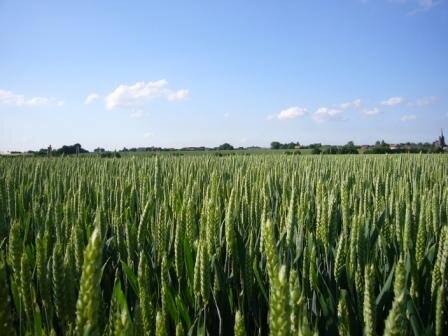The winter wheat breeding programme of DSV is designed to produce varieties that span the end-market use. With a number of scientific tools at our disposal, we are able to select lines which provide a high bread-making quality with a good disease resistance package without sacrificing yield. Additionally, we aim to produce varieties for feed with a top yield and resistance to major wheat diseases.
The process starts by selecting mother and father lines that could complement each other. For example, a very high yielding variety with a yellow rust problem might be crossed with a high yielding variety with excellent yellow rust resistance. Wheat is a self-pollinating, cleistogamous species and so to introduce the father line, the mother line must first be emasculated. This is achieved by opening each flower and removing all the pollen-bearing anthers. Next, the pollen from the father line is introduced to the stigma (female flower parts) of the mother line. When this plant sets seed, it will be a combination of the mother and father’s genetic information.
The subsequent generations of this new cross are put through a rigorous selection process to reduce the number of potential varieties from thousands to just one or two. This process involves artificially and naturally increasing disease pressure to identify those lines susceptible to disease – these lines are then discarded. Yields are also taken so that only the high yielding lines are carried forward. At later generations, each line is replicated at various sites around the UK, not only to give a more reliable dataset but also to highlight any lines better suited to certain locations. DSV also carries out extensive quality testing to ascertain the bread-making potential of each line. Grain from different trial locations are milled on site and analysed for rheology before being sent to commercial bakers for bread-making studies.
In order to be accepted as a variety, the winter wheat line must be distinct from any other and offer advantages over existing varieties. In addition to these criteria, the wheat must be genetically stable. As wheat is a self-pollinating crop, the genes become increasingly fixed at each generation – coupled to the artificial selection described above, this produces the best possible combination of the original two parents. To speed this process up, a technology called double haploid production (DH) can be applied. This involves taking a large number of mother-father genetic combinations, removing one copy of all the genes and doubling the remaining genetic information. DH produces wheat plants that have an identical pair of every gene from an early stage.
Another scientific technique at the disposal of DSV is the use of marker assisted selection. A marker is a small piece of identifiable DNA that lies close to a wheat gene. Genetic information is taken from each potential variety and analysed for the presence of certain important markers. For example, we can identify lines that contain an eyespot resistance marker or a marker that indicates resistance to orange wheat blossom midge. This is useful when selecting with which lines to continue in the breeding process and gives varieties an added advantage when farmers come to decide what to sow.

